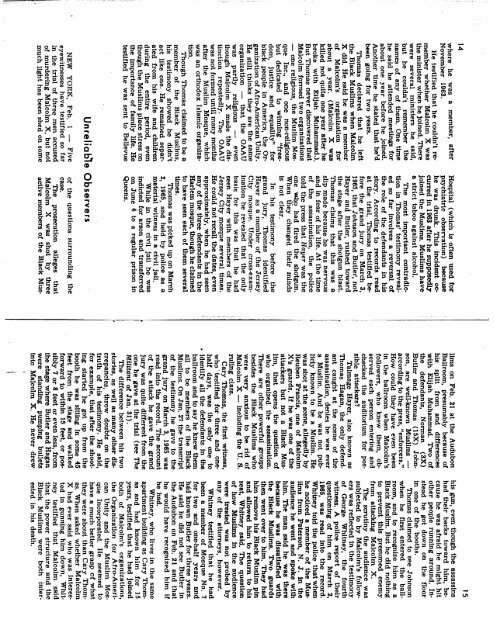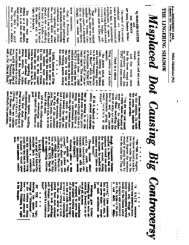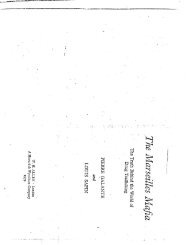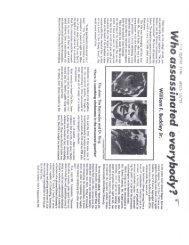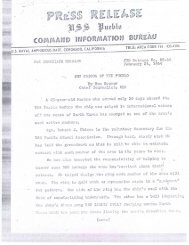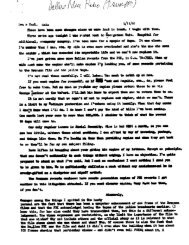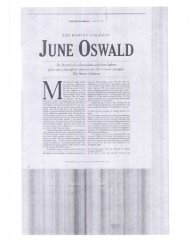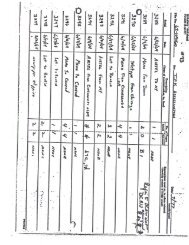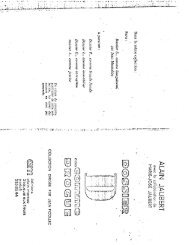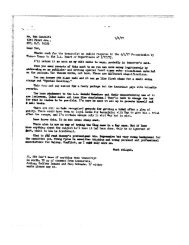THE ASSASSINATION OF MALCOLM X
THE ASSASSINATION OF MALCOLM X
THE ASSASSINATION OF MALCOLM X
You also want an ePaper? Increase the reach of your titles
YUMPU automatically turns print PDFs into web optimized ePapers that Google loves.
lirns on Feb. 21 at the Audubon<br />
Ballroom, presumably because of<br />
his split from and differences<br />
with Elijah Muhammad. Two of<br />
the defendants, Norman (3X)<br />
Butler and Thomas (15X) Johnson,<br />
are well-known Muslims -<br />
according to the press, "enforcers."<br />
How could they have even been<br />
in the ballroom when Malcolm's<br />
followers, who knew them, observed<br />
each person entering and<br />
checked the auditorium for possible<br />
attackers?<br />
Talmage Hayer, also known as<br />
Thomas Hagan, the only defendant<br />
caught at the scene of the<br />
assassination, denies he was ever<br />
a Muslim. And he was not publicly<br />
known to be a Muslim. He<br />
was shot at the scene, allegedly by<br />
Reuben Francis, one of Malcolm<br />
X's guards. If he was one of the<br />
attackers but not a Black Muslim,<br />
that opens the question of<br />
who organized the assassination.<br />
There are other powerful groups<br />
besides the Black Muslims who<br />
were very anxious to be rid of<br />
Malcolm X — including the U. S.<br />
ruling class.<br />
Cary Thomas, the first witness,<br />
who ' testified for three and onehalf<br />
days, was the only one to<br />
• identify all the defendants in the<br />
ballroom and to say he knew them<br />
all to be members of the Black<br />
Muslims. On Jan. 27 the transcript<br />
of the testimony he gave to the<br />
grand jury on March 3, 1965 was<br />
read into the record. The account<br />
of the attack he gave the grand<br />
jury was quite different from the<br />
one he gave at the trial (see The<br />
Militant of Jan. 31).<br />
The difference between his two<br />
stories, as well as many other discrepancies,<br />
throw doubts on the<br />
truth of his testimony. He said,<br />
for example, that after the shooting<br />
started he got up from the<br />
booth he was sitting in some 45<br />
feet from the stage and walked<br />
forward to within 15 feet, or possibly<br />
7 or 8 feet or even less, from<br />
the stage where Butler and Hagan<br />
were standing pumping bullets<br />
into Malcolm X. He never drew<br />
15<br />
his gun, even though the assassins<br />
had their backs toward him, because<br />
he was afraid he might hit<br />
other people running around. Instead<br />
he got down on the floor<br />
in one of the booths.<br />
Thomas claimed to see Johnson<br />
when he first entered the ballroom,<br />
and to recognize him as a<br />
Black Muslim. But he did nothing<br />
to prevent this presumed enemy<br />
from attacking Malcolm X.<br />
The scrutiny the audience was<br />
subjected to by Malcolm's followers<br />
was reflected in the testimony<br />
of George Whitney, the fourth<br />
witness. A police report of their<br />
questioning of him on March 2,<br />
1965, was read into the record.<br />
Whitney told the police that when<br />
he noticed a member of the Muslims<br />
from Paterson, N. J. in the<br />
audience he went and spoke with<br />
him. The man said he was there<br />
because he was dissatisfied with<br />
the Black Muslims. Two guards<br />
then went over to him. They had<br />
him remove his Black Muslim pin<br />
and allowed him to return to his<br />
seat, Whitney said. The question<br />
of how Muslims in the audience<br />
were treated was not probed by<br />
any of the attorneys, however.<br />
Whitney testified that he had<br />
been a member of Mosque No. 7<br />
for two and one-half years and<br />
hdd known Butler for three years.<br />
He said he did not see Butler in<br />
the Audubon on Feb. 21 and that<br />
he would have recognized him if<br />
he had.<br />
Whitney, who lives in the same<br />
apartment building as Cary Thomas<br />
and had known him for 15<br />
years, testified that he had joined<br />
both of Malcolm's organizations,<br />
the Organization for Afro-American<br />
Unity and the Muslim Mosque<br />
Incorporated. He seemed to<br />
have a much better grasp of what<br />
they were about than Cary Thomas.<br />
When asked whether Malcolm<br />
X had ever said who was interested<br />
in gunning him down, Whitney<br />
testified that Malcolm said<br />
that the power structure and the<br />
Black Muslims were both interested<br />
in his death.<br />
NEW YORK, Feb. 1 — Five<br />
eyewitnesses have testified so far<br />
in the trial of three men accused<br />
of murdering Malcolm X, but not<br />
much light has been shed on some<br />
of the questions surrounding the<br />
case.<br />
The prosecution alleges that<br />
Malcolm X was shot by three<br />
active members of the Black Mus-<br />
Unreliable Observers<br />
14<br />
where he was a member, after<br />
November 1963.<br />
He testified that he couldn't remember<br />
whether Malcolm X was<br />
the minister when he joined. There<br />
were several ministers he said,<br />
but he couldn't remember the<br />
names of any of them. One time<br />
he said he attended meetings for<br />
about one year before he joined.<br />
Another time he stated that he'd<br />
been going for two years.<br />
Thomas declared that he left<br />
the Black Muslims when Malcolm<br />
X did. He said he was a member<br />
of Malcolm's organization for<br />
about a year. (Malcolm X was<br />
killed not quite one year after he<br />
broke with Elijah Muhammad.).<br />
But Thomas never discovered that<br />
Malcolm formed two organizations<br />
— one religious, the Muslim Mosque<br />
Inc., and one non-religious<br />
but dedicated to winning "freedom,<br />
justice and equality" for<br />
black people in America, the Organization<br />
of Afro-American Unity.<br />
He still thinks they are the same<br />
organization — that the OAAU<br />
was partly religious — even<br />
though Malcolm X made the distinction<br />
repeatedly. The OAAU<br />
was not formed until many months<br />
after the Muslim Mosque, which<br />
was an orthodox Islamic organization.<br />
Though Thomas claimed to be a<br />
member of the Black Muslims,<br />
his testimony showed he didn't<br />
act like one. He remained separated<br />
from his wife and children<br />
during the entire period, even<br />
though the Muslims place stress on<br />
the importance of family life. He<br />
testified he was sent to Bellevue<br />
Hospital (which is often used for<br />
psychiatric observation) because<br />
he was drunk. This incident occurred<br />
in 1963 after he supposedly<br />
joined the Muslims. Muslims have<br />
a strict taboo against alcohol.<br />
The most important contradiction<br />
in Thomas' testimony revealed<br />
so far involves a reversal of<br />
the role of the defendants in his<br />
story. According to records read<br />
at the trial, Thomas testified before<br />
the grand jury on March 3,<br />
1965, that Johnson. and Butler, not<br />
Hayer and Butler, rushed toward<br />
the stage after the shotgun blast.<br />
Thomas claims that this was a<br />
slip made because he was nervous<br />
and in fear of his life. At the time<br />
of the assassination, the police<br />
told the press that Hayer was the<br />
one who had fired the shotgun.<br />
When they changed their minds<br />
is not clear.<br />
In his testimony before the<br />
grand jury, Thomas identified<br />
Hayer as a member of the Jersey<br />
City mosque. Under cross-examination<br />
he revealed that the only<br />
basis for this was that he had<br />
seen Hayer with members of the<br />
Jersey City mosque several times.<br />
He could not recall the dates, even<br />
approximately, when he had seen<br />
any of the three defendants in the<br />
Harlem mosque, though he claimed<br />
to have seen each of them several<br />
times.<br />
Thomas was picked up on March<br />
2, 1965, and held by police as a<br />
material witness in a civil jail.<br />
While in the civil jail he was<br />
indicted for arson and transferred<br />
on June 4 to a regular prison in<br />
Queens.


